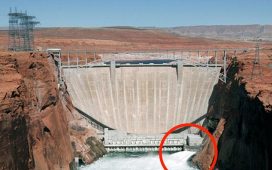Mysterious 3,000-foot-long interstellar object ‘Oumuamua is NOT an iceberg made out of pure nitrogen because there’s not enough in the known universe to make an object that big, scientists say
- ‘Oumuamua is not a nitrogen iceberg, Harvard researchers say, refuting a study from March
- There is not enough nitrogen in the known universe to make an object that size
- ‘Oumuamua is between 300-3,000 feet long and 115-548 feet thick
- Scientists are attempting to understand why it appeared to accelerate as it was leaving the solar system
- The mysterious oblong interstellar object was first discovered in October 2017
The scientific community has long debated what the interstellar object ‘Oumuamua is, but one group of researchers believes it is not a nitrogen iceberg, according to a new study.
A team of researchers, including the Harvard astrophysicist who suggested ‘Oumuamua was a ‘lightsail’ sent from another civilization, note there is not enough nitrogen in the known universe to make an object that size.
It is believed that ‘Oumuamua is somewhere between 300 and 3,000 feet in length and could be anywhere between 115 and 548 feet thick.
As such, it’s likely that it is not a chunk of a Pluto-like exoplanet that broke off 400 million years ago, as some have posturized.

‘Oumuamua is not a nitrogen iceberg, Harvard researchers say, refuting a study from March

There is not enough nitrogen in the known universe to make an object that size. As such, it’s likely that it is not a chunk of a Pluto-like exoplanet that broke off 400 million years ago, as some have posturized
‘The necessary mass of heavy elements exceeds the total quantity locked in stars with 95% confidence, making the scenario untenable because only a small fraction of the mass in stars ends in exo-Plutos,’ the study’s researchers, Amir Siraj and Avi Loeb, wrote.
A number of theories – including that it is a hydrogen iceberg or nitrogen iceberg- have been postulated about the origins or the composition of the oblong cigar-shaped ‘Oumuamua since it was first discovered in October 2017.
In an interview with Live Science, Siraj said ‘that there was no physical mechanism for it to work,’ referencing the research put together by Arizona State University astrophysicists Alan Jackson and Steven Desch in March.
‘And not even the error budget for it to work.’
In June, researchers from Yale attempted to explain why ‘Oumuamua seemed to accelerated in space and suggested it was made of hydrogen.

Scientists are attempting to understand why it appeared to accelerate as it was leaving the solar system

The mysterious oblong interstellar object was first discovered in October 2017; it is one of two interstellar objects to be discovered
In the solar system, pure nitrogen has only been found on Pluto and if all the pure nitrogen came from other Pluto-like planets that are believed to exist, it still wouldn’t be enough, Siraj told Live Science.
In an interview with DailyMail.com, Loeb said the argument is based on ‘simple mass budget accounting.’
‘We show that there is not enough nitrogen in all the stars within the Milky Way to account for a large enough population of icebergs that would explain the discovery of `Oumuamua,’ Loeb said via email.
‘Oumuamua was first discovered in October 2017, flying at a speed of nearly 57,000mph, making it likely that it did not originate in the solar system.’
He continued: ‘Even when allowing for the most generous assumptions, the nitrogen supply is short of making enough icebergs to explain `Oumuamua.
‘The discrepancy is not marginal but by orders of magnitude, especially when taking into account evaporation by cosmic rays.’
The research was published earlier this month in the scientific journal New Astronomy.














